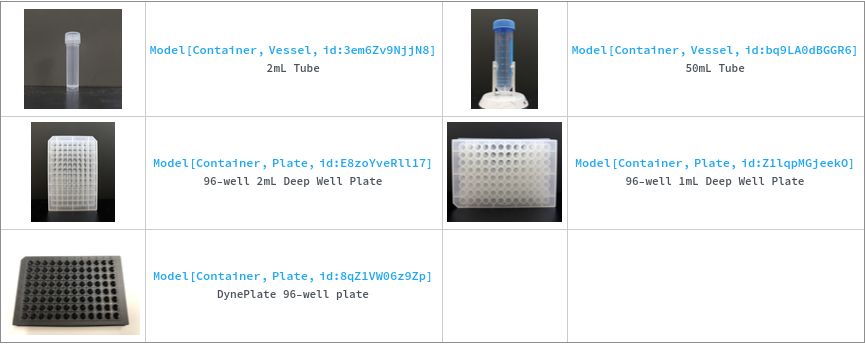ExperimentMeasureSurfaceTension
ExperimentMeasureSurfaceTension[Samples]⟹Protocol
generates a Protocol object for determining the surface tensions of input Samples at varying concentrations.
Surface Tension is the energy required to form a new surface by unit area. The surface tension of a sample is determined by measuring the forces exerted on a small diameter rod as it is withdrawn from a sample. Typically, polar solvents have higher surface tensions than their non-polar counterparts and the adsorption of surfactants lowers surface tension. Surfactants also form micelles above critical micelle concentration. Above this concentration, all additional surfactant increases the micelle concentration rather than the concentration of surfactant monomers. The surface tension decreases with increasing surfactant concentration up to this point and then remains constant.
Experimental Principles

Figure 1.1: Procedural overview of a MeasureSurfaceTension experiment. Step 1: Samples are mixed with Diluent to create a SerialDilutionCurve or DilutionCurve. After the samples are diluted, they are loaded onto an assay plate. Step 2: Samples are left to equilibrate. Step 3: The probes are cleaned by dipping them into cleaning solutions and/or by burning off the contaminants with a probe cleaner. Step 4: The probes are then calibrated by measuring a Calibrant with known surface tension. After calibration, the surface tensions of the samples are measured with optional cleaning between measurements.
Instrumentation
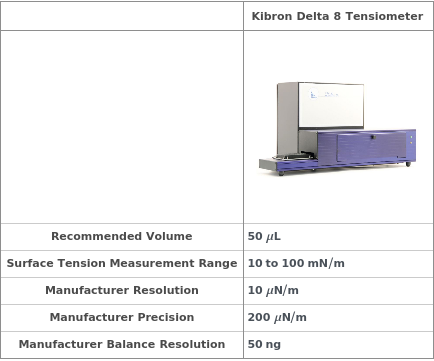
Kibron Delta 8 Tensiometer

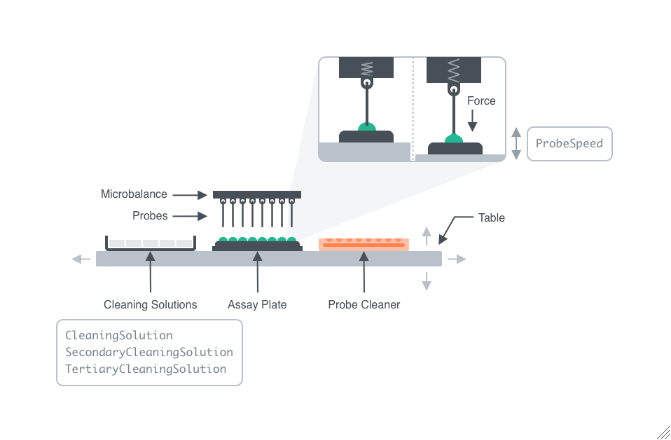
Figure 2.1.1: An assay plate, probe cleaner and cleaning solutions sit on a moveable table. The table moves left and right to position these objects under probes hanging from microbalances. The table then moves up and down to either dip the probes in and out of the cleaning solutions, put them in contact with a probe cleaner that heats up to 1000C or dip them in and out of a sample. The forces on the probes as they are pulled out of samples is used to calculate their surface tension.
Experiment Options
General
Instrument
Pattern Description: An object of type or subtype Model[Instrument, Tensiometer] or Object[Instrument, Tensiometer]
NumberOfReplicates
The number of times the given dilution series should be replicated to obtain additional surface tension measurements.
PreparedPlate
Indicates if the input plates have been prepared prior to the start of the experiment. If True, the samples in column 12 of the plate will be used as a Calibrant.
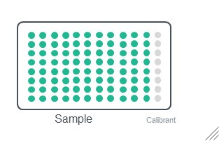
Figure 3.1: Use the PreparedPlate option to input an already prepared plate into the experiment. Column 12 of the plate will be used as a calibrant.
Protocol
SampleLoadingVolume
Pattern Description: Greater than or equal to 40 microliters and less than or equal to 60 microliters.
Sample Preparation
DilutionCurve
The collection of dilutions that will be performed on sample before measuring surface tension. SampleLoadingVolume of each dilution will be transferred to the measurement plate. For Fixed Dilution Volume Dilution Curves, the Sample Amount is the volume of the sample that will be mixed the Diluent Volume of the Diluent to create a desired concentration. For Fixed Dilution Factor Dilution Curves, the Sample Volume is the volume of the sample that will created after being diluted by the Dilution Factor. For example, a 1M sample with a dilution factor of 0.7 will be diluted to a concentration 0.7M.
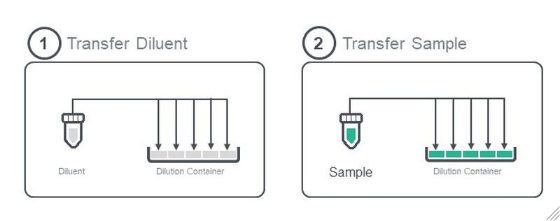
Figure 3.2: Use the DilutionCuve option to create a collection of dilutions that will be performed on the sample before measuring surface tension.
Default Calculation: This is automatically set Null if Diluent is set to Null or a Serial Dilution Curve is specified.
Programmatic Pattern: (({{GreaterEqualP[0*Microliter], GreaterEqualP[0*Microliter]}..} | {{GreaterEqualP[40*Microliter], RangeP[0, 1]}..}) | Automatic) | Null
SerialDilutionCurve
The collection of dilutions that will be performed on sample before measuring surface tension. SampleLoadingVolume of each dilution will be transferred to the measurement plate. For Serial Dilution Volumes, the Transfer Volume is taken out of the sample and added to a second well with the Diluent Volume of the Diluent. It is mixed, then the Transfer Volume is taken out of that well to be added to a third well. This is repeated to make Number Of Dilutions diluted samples. For example, if a 100mM sample with a Transfer Volume of 20 Microliters, a Diluent Volume of 60 Microliters and a Number of Dilutions of 3 is used, it will create a DilutionCurve of 100mM, 25mM, 6.25mM, 1.5625mM and 0mM with each dilution having a volume of 60 Microliters. For Serial Dilution Factors, the sample will be diluted by the dilution factor at each transfer step.
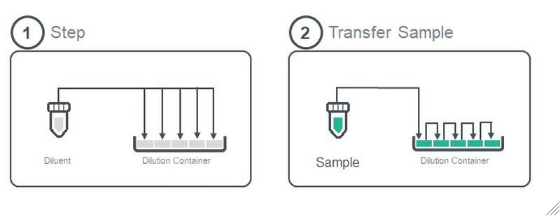
Figure 3.3: Use the SerialDilutionCuve option to create a collection of serial dilutions that will be performed on the sample before measuring surface tension.
Default Calculation: This is automatically set Null if Diluent is set to Null or a non-serial Dilution Curve is specified. In all other cases it is automatically set to a Sample Volume of 100 Microliters and a Constant Dilution Factor of 0.7. The Number Of Dilutions is automatically set to 21 if the Diluent is the same as the Calibrant and 20 if they are different.
Programmatic Pattern: (({GreaterP[0*Microliter], GreaterEqualP[40*Microliter], GreaterP[1, 1]} | {GreaterEqualP[40*Microliter], {RangeP[0, 1], GreaterP[1, 1]} | {RangeP[0, 1]..}}) | Automatic) | Null
Diluent
Default Calculation: If the measurement is to be performed with a DilutionCurve that has No Dilution, this is automatically set to Null. Otherwise, it is automatically set to Model[Sample, "Milli-Q water"].
Pattern Description: An object of type or subtype Model[Sample] or Object[Sample] or a prepared sample or Null.
DilutionContainer
The containers in which each sample is diluted with the Diluent to make the concentration series, with indices indicating specific grouping of samples if desired.
Default Calculation: Automatically set as Model[Container,Plate,"96-well 2mL Deep Well Plate"], grouping samples with the same container and DilutionStorageCondition.
Programmatic Pattern: ((ObjectP[{Model[Container]}] | {GreaterEqualP[1, 1] | Automatic, ObjectP[{Model[Container]}] | Automatic}) | Automatic) | Null
DilutionStorageCondition
The conditions under which any leftover samples from the DilutionCurve should be stored after the samples are transferred to the measurement plate.
Pattern Description: {AmbientStorage, Refrigerator, Freezer, DeepFreezer, CryogenicStorage, YeastIncubation, BacteriaIncubation, MammalianIncubation, TissueCultureCellsIncubation, MicrobialCellsIncubation, MicrobialCellsShakingIncubation, YeastCellsIncubation, YeastCellsShakingIncubation, ViralIncubation, AcceleratedTesting, IntermediateTesting, LongTermTesting, UVVisLightTesting} or Disposal or Null.
DilutionMixVolume
The volume that is pipetted out and in of the dilution to mix the sample with the Diluent to make the DilutionCurve.
Default Calculation: Automatically set to the TransferVolume for serial dilutions, and 40 Microliters for fixed dilutions.
Pattern Description: Greater than or equal to 0 microliters and less than or equal to 900 microliters or Null.
DilutionNumberOfMixes
The number of pipette out and in cycles that is used to mix the sample with the Diluent to make the DilutionCurve.
Pattern Description: Greater than or equal to 0 and less than or equal to 20 in increments of 1 or Null.
DilutionMixRate
The speed at which the DilutionMixVolume is pipetted out and in of the dilution to mix the sample with the Diluent to make the DilutionCurve.
Default Calculation: Automatically set to 100 Microliter/Second if the sample is diluted and Null otherwise.
Pattern Description: Greater than or equal to 0.4 microliters per second and less than or equal to 250 microliters per second or Null.
ImageDilutionContainers
SingleSamplePerProbe
Indicates if the samples should be arranged on the measurement plate so that there is only one input sample in each row. This will make sure only one sample will come into contact with each probe. The dilution curves of the samples will arranged so that they are measured with increasing concentration. If the dilution curves of the samples do not take up full rows, some of the wells will remain empty. If this is set to False, the samples will arranged in columns 1-11 of the plate without skipping any wells. Column 12 is taken up by the calibrant. The plate is read right to left, starting with column 12.
Default Calculation: Automatically set to False if there are no dilution curves, a CleaningMethod is specified and there are more than eight samples. It is set to True in all other cases.
Cleaning
CleaningSolution
The first solution used to clean the tensiometer probes. The probes are dipped into three solutions during the cleaning process.
Default Calculation: Automatically set to Model[Sample, StockSolution, "70% ethanol cleaning solution for tensiometer"] if the PreCleaningMethod or CleaningMethod involves Solution and Null otherwise.
Pattern Description: An object of type or subtype Model[Sample], Object[Sample], or Object[Container, Vessel] or a prepared sample or Null.
Programmatic Pattern: ((ObjectP[{Model[Sample], Object[Sample], Object[Container, Vessel]}] | _String) | Automatic) | Null
SecondaryCleaningSolution
The second solution used to clean the tensiometer probes. The probes are dipped into three solutions during the cleaning process.
Default Calculation: Automatically set to Model[Sample, "Milli-Q water"] if the PreCleaningMethod or CleaningMethod involves Solution and Null otherwise.
Pattern Description: An object of type or subtype Model[Sample], Object[Sample], or Object[Container, Vessel] or a prepared sample or Null.
Programmatic Pattern: ((ObjectP[{Model[Sample], Object[Sample], Object[Container, Vessel]}] | _String) | Automatic) | Null
TertiaryCleaningSolution
The third solution used to clean the tensiometer probes. The probes are dipped into three solutions during the cleaning process.
Pattern Description: An object of type or subtype Model[Sample], Object[Sample], or Object[Container, Vessel] or a prepared sample or Null.
Programmatic Pattern: (ObjectP[{Model[Sample], Object[Sample], Object[Container, Vessel]}] | _String) | Null
PreCleaningMethod
The method used to clean the tensiometer probes before measurements begin. If Burn is selected, the probes will be cleaned with an internal probe cleaner designed to heat off contaminants. This probe cleaning process involves the probes coming into contact with a hot surface for three short preheating pulses, followed by a long burning pulse and a cooling off time. If Solution is selected the probes will be dipped in and out of a cleaning solution. If both are selected, the probes will be cleaned with the solution then burned with the probe cleaner.
CleaningMethod
The method used to clean the tensiometer probes between all measurements within a single dilution curve. The probes are always cleaned before a new set of measurements and the samples in dilution series are measured starting with the most dilute samples. If Burn is selected, the probes will be cleaned with an internal probe cleaner designed to heat off contaminants. This probe cleaning process involves the probes coming into contact with a hot surface for three short preheating pulses, followed by a long burning pulse and a cooling off time. If Solution is selected the probes will be dipped in and out of a cleaning solution. If both are selected, the probes will be cleaned with the solution then burned with the probe cleaner.
PreheatingTime
The duration of one of three short heating pulses used by the instrument's internal probe cleaner to preheat the probes before the primary cleaning pulse.
BurningTime
The duration of the primary cleaning pulse used by the instrument's internal probe cleaner to burn contaminants off the probes before a new plate is measured.
CoolingTime
The duration of the cooling period after the instrument's internal probe cleaner issues a primary cleaning pulse and before a new plate is measured.
BetweenMeasurementBurningTime
The duration of the primary cleaning pulse used by the instrument's internal probe cleaner to burn contaminants off the probes between all measurements within a single dilution curve (of the same sample).
Pattern Description: Greater than or equal to 0 seconds and less than or equal to 10 seconds or Null.
BetweenMeasurementCoolingTime
The duration of the cooling period between measurements after the instrument's internal probe cleaner issues a primary cleaning pulse and before a new measurement within a single dilution curve (of the same sample).
Pattern Description: Greater than or equal to 0 seconds and less than or equal to 10 seconds or Null.
MaxCleaningNoise
The maximum noise accepted before the probes are brought into contact with the instrument's internal probe cleaner.
Pattern Description: Greater than or equal to 0.05 millinewtons per meter and less than or equal to 0.2 millinewtons per meter.
Post Experiment
SamplesOutStorageCondition
The conditions under which the samples in the assay plate should be stored after the protocol is completed. The samples in the plate will be transferred into ContainerOut.
Pattern Description: {AmbientStorage, Refrigerator, Freezer, DeepFreezer, CryogenicStorage, YeastIncubation, BacteriaIncubation, MammalianIncubation, TissueCultureCellsIncubation, MicrobialCellsIncubation, MicrobialCellsShakingIncubation, YeastCellsIncubation, YeastCellsShakingIncubation, ViralIncubation, AcceleratedTesting, IntermediateTesting, LongTermTesting, UVVisLightTesting} or Disposal.
ContainerOut
Default Calculation: Automatically set to Null if the SamplesOutStorageCondition is set to Disposal and Model[Container,Plate,"96-well 2mL Deep Well Plate"] in all other cases.
SamplesInStorageCondition
The non-default conditions under which the SamplesIn of this experiment should be stored after the protocol is completed. If left unset, SamplesIn will be stored according to their current StorageCondition.
Pattern Description: {AmbientStorage, Refrigerator, Freezer, DeepFreezer, CryogenicStorage, YeastIncubation, BacteriaIncubation, MammalianIncubation, TissueCultureCellsIncubation, MicrobialCellsIncubation, MicrobialCellsShakingIncubation, YeastCellsIncubation, YeastCellsShakingIncubation, ViralIncubation, AcceleratedTesting, IntermediateTesting, LongTermTesting, UVVisLightTesting} or Disposal or Null.
Calibration
NumberOfCalibrationMeasurements
The number of times surface tension of the calibration liquid is measured before taking the sample measurements. The average of these measurements is used in the calibration.
Calibrant
The sample that is used to measure a calibration factor used to convert the readings from the balances to surface tension values. Each probe is calibrated before the surface tensions of a sample's dilution curve is measured. A sample with a known surface tension is needed for this calibration.
Default Calculation: Automatically set to the Diluent if the Diluent has a populated SurfaceTension field or Model[Sample, "Milli-Q water"] in all other cases.
Pattern Description: An object of type or subtype Model[Sample] or Object[Sample] or a prepared sample.
CalibrantSurfaceTension
Default Calculation: Automatically set to be the SurfaceTension value stored in the model of the selected Calibrant.
Pattern Description: Greater than or equal to 10 millinewtons per meter and less than or equal to 100 millinewtons per meter.
MaxCalibrationNoise
The maximum noise (probe vibration) accepted while the probes are in the air before the probes are moved into the calibration sample.
Pattern Description: Greater than or equal to 0.05 millinewtons per meter and less than or equal to 0.2 millinewtons per meter.
Measurement
EquilibrationTime
The minimum amount of time, after being plated but before readings begin, used for the sample to equilibrate.
NumberOfSampleMeasurements
The number of times the surface tension of each dilution of the sample is measured. These measurements are taken consecutively before moving to the next column of the plate.
ProbeSpeed
The percentage of the default speed that is used to move the measurement table down, pulling the probe out of the liquid. Smaller settings improve accuracy of samples with higher viscosities. A probe speed of 100% is appropriate for samples with viscosities in the 0-40 cP range. A probe speed of 30% can measure samples with viscosities up to 100 cP.
MaxDryNoise
The maximum noise (probe vibration) accepted while the probes are in the air before the probes are moved into the sample.
Pattern Description: Greater than or equal to 0.05 millinewtons per meter and less than or equal to 0.2 millinewtons per meter.
MaxWetNoise
The maximum noise (probe vibration) accepted while the probes are in the sample liquid before the probes are pulled out of the liquid to take the measurement.
Sample Prep Options
Sample Preparation
PreparatoryUnitOperations
Specifies a sequence of transferring, aliquoting, consolidating, or mixing of new or existing samples before the main experiment. These prepared samples can be used in the main experiment by referencing their defined name. For more information, please reference the documentation for ExperimentSampleManipulation.
Pattern Description: List of one or more unit Operation ManualSamplePreparation or RoboticSamplePreparation or unit Operation must match SamplePreparationP entries or Null.
Programmatic Pattern: {((ManualSamplePreparationMethodP | RoboticSamplePreparationMethodP) | SamplePreparationP)..} | Null
PreparatoryPrimitives
Specifies a sequence of transferring, aliquoting, consolidating, or mixing of new or existing samples before the main experiment. These prepared samples can be used in the main experiment by referencing their defined name. For more information, please reference the documentation for ExperimentSampleManipulation.
Pattern Description: List of one or more a primitive with head Define, Transfer, Mix, Aliquot, Consolidation, FillToVolume, Incubate, Filter, Wait, Centrifuge, or Resuspend entries or Null.
Preparatory Incubation
Incubate
Indicates if the SamplesIn should be incubated at a fixed temperature prior to starting the experiment or any aliquoting. Sample Preparation occurs in the order of Incubation, Centrifugation, Filtration, and then Aliquoting (if specified).
Default Calculation: Resolves to True if any of the corresponding Incubation options are set. Otherwise, resolves to False.
IncubationTemperature
Temperature at which the SamplesIn should be incubated for the duration of the IncubationTime prior to starting the experiment.
Pattern Description: Ambient or greater than or equal to -20 degrees Celsius and less than or equal to 500 degrees Celsius or Null.
Programmatic Pattern: ((Ambient | RangeP[$MinIncubationTemperature, $MaxIncubationTemperature]) | Automatic) | Null
IncubationTime
Duration for which SamplesIn should be incubated at the IncubationTemperature, prior to starting the experiment.
Mix
Default Calculation: Automatically resolves to True if any Mix related options are set. Otherwise, resolves to False.
MixType
Default Calculation: Automatically resolves based on the container of the sample and the Mix option.
Pattern Description: Roll, Vortex, Sonicate, Pipette, Invert, Stir, Shake, Homogenize, Swirl, Disrupt, or Nutate or Null.
MixUntilDissolved
Indicates if the mix should be continued up to the MaxIncubationTime or MaxNumberOfMixes (chosen according to the mix Type), in an attempt dissolve any solute. Any mixing/incubation will occur prior to starting the experiment.
Default Calculation: Automatically resolves to True if MaxIncubationTime or MaxNumberOfMixes is set.
MaxIncubationTime
Maximum duration of time for which the samples will be mixed while incubated in an attempt to dissolve any solute, if the MixUntilDissolved option is chosen. This occurs prior to starting the experiment.
Default Calculation: Automatically resolves based on MixType, MixUntilDissolved, and the container of the given sample.
IncubationInstrument
Default Calculation: Automatically resolves based on the options Mix, Temperature, MixType and container of the sample.
Pattern Description: An object of type or subtype Model[Instrument, Roller], Model[Instrument, OverheadStirrer], Model[Instrument, Vortex], Model[Instrument, Shaker], Model[Instrument, BottleRoller], Model[Instrument, Roller], Model[Instrument, Sonicator], Model[Instrument, HeatBlock], Model[Instrument, Homogenizer], Model[Instrument, Disruptor], Model[Instrument, Nutator], Model[Instrument, Thermocycler], Model[Instrument, EnvironmentalChamber], Model[Instrument, Pipette], Object[Instrument, Roller], Object[Instrument, OverheadStirrer], Object[Instrument, Vortex], Object[Instrument, Shaker], Object[Instrument, BottleRoller], Object[Instrument, Roller], Object[Instrument, Sonicator], Object[Instrument, HeatBlock], Object[Instrument, Homogenizer], Object[Instrument, Disruptor], Object[Instrument, Nutator], Object[Instrument, Thermocycler], Object[Instrument, EnvironmentalChamber], or Object[Instrument, Pipette] or Null.
AnnealingTime
Minimum duration for which the SamplesIn should remain in the incubator allowing the system to settle to room temperature after the IncubationTime has passed but prior to starting the experiment.
IncubateAliquotContainer
The desired type of container that should be used to prepare and house the incubation samples which should be used in lieu of the SamplesIn for the experiment.
Programmatic Pattern: ((ObjectP[Model[Container]] | {GreaterEqualP[1, 1] | (Automatic | Null), (ObjectP[{Model[Container], Object[Container]}] | _String) | Automatic}) | Automatic) | Null
IncubateAliquotDestinationWell
The desired position in the corresponding IncubateAliquotContainer in which the aliquot samples will be placed.
Default Calculation: Automatically resolves to A1 in containers with only one position. For plates, fills wells in the order provided by the function AllWells.
IncubateAliquot
The amount of each sample that should be transferred from the SamplesIn into the IncubateAliquotContainer when performing an aliquot before incubation.
Default Calculation: Automatically set as the smaller between the current sample volume and the maximum volume of the destination container.
Pattern Description: All or greater than or equal to 1 microliter and less than or equal to 20 liters or Null.
Preparatory Centrifugation
Centrifuge
Indicates if the SamplesIn should be centrifuged prior to starting the experiment or any aliquoting. Sample Preparation occurs in the order of Incubation, Centrifugation, Filtration, and then Aliquoting (if specified).
Default Calculation: Resolves to True if any of the corresponding Centrifuge options are set. Otherwise, resolves to False.
CentrifugeInstrument
Pattern Description: An object of type or subtype Model[Instrument, Centrifuge] or Object[Instrument, Centrifuge] or Null.
Programmatic Pattern: (ObjectP[{Model[Instrument, Centrifuge], Object[Instrument, Centrifuge]}] | Automatic) | Null
CentrifugeIntensity
The rotational speed or the force that will be applied to the samples by centrifugation prior to starting the experiment.
Pattern Description: Greater than 0 revolutions per minute or greater than 0 standard accelerations due to gravity on the surface of the earth or Null.
Programmatic Pattern: ((GreaterP[0*RPM] | GreaterP[0*GravitationalAcceleration]) | Automatic) | Null
CentrifugeTime
CentrifugeTemperature
The temperature at which the centrifuge chamber should be held while the samples are being centrifuged prior to starting the experiment.
Pattern Description: Ambient or greater than or equal to -10 degrees Celsius and less than or equal to 40 degrees Celsius or Null.
CentrifugeAliquotContainer
The desired type of container that should be used to prepare and house the centrifuge samples which should be used in lieu of the SamplesIn for the experiment.
Programmatic Pattern: ((ObjectP[Model[Container]] | {GreaterEqualP[1, 1] | (Automatic | Null), (ObjectP[{Model[Container], Object[Container]}] | _String) | Automatic}) | Automatic) | Null
CentrifugeAliquotDestinationWell
The desired position in the corresponding AliquotContainer in which the aliquot samples will be placed.
Default Calculation: Automatically resolves to A1 in containers with only one position. For plates, fills wells in the order provided by the function AllWells.
CentrifugeAliquot
The amount of each sample that should be transferred from the SamplesIn into the CentrifugeAliquotContainer when performing an aliquot before centrifugation.
Default Calculation: Automatically set as the smaller between the current sample volume and the maximum volume of the destination container.
Pattern Description: All or greater than or equal to 1 microliter and less than or equal to 20 liters or Null.
Preparatory Filtering
Filtration
Indicates if the SamplesIn should be filter prior to starting the experiment or any aliquoting. Sample Preparation occurs in the order of Incubation, Centrifugation, Filtration, and then Aliquoting (if specified).
Default Calculation: Resolves to True if any of the corresponding Filter options are set. Otherwise, resolves to False.
FiltrationType
Default Calculation: Will automatically resolve to a filtration type appropriate for the volume of sample being filtered.
FilterInstrument
Default Calculation: Will automatically resolved to an instrument appropriate for the filtration type.
Pattern Description: An object of type or subtype Model[Instrument, FilterBlock], Object[Instrument, FilterBlock], Model[Instrument, PeristalticPump], Object[Instrument, PeristalticPump], Model[Instrument, VacuumPump], Object[Instrument, VacuumPump], Model[Instrument, Centrifuge], Object[Instrument, Centrifuge], Model[Instrument, SyringePump], or Object[Instrument, SyringePump] or Null.
Programmatic Pattern: (ObjectP[{Model[Instrument, FilterBlock], Object[Instrument, FilterBlock], Model[Instrument, PeristalticPump], Object[Instrument, PeristalticPump], Model[Instrument, VacuumPump], Object[Instrument, VacuumPump], Model[Instrument, Centrifuge], Object[Instrument, Centrifuge], Model[Instrument, SyringePump], Object[Instrument, SyringePump]}] | Automatic) | Null
Filter
The filter that should be used to remove impurities from the SamplesIn prior to starting the experiment.
Default Calculation: Will automatically resolve to a filter appropriate for the filtration type and instrument.
Pattern Description: An object of type or subtype Model[Container, Plate, Filter], Model[Container, Vessel, Filter], or Model[Item, Filter] or Null.
Programmatic Pattern: (ObjectP[{Model[Container, Plate, Filter], Model[Container, Vessel, Filter], Model[Item, Filter]}] | Automatic) | Null
FilterMaterial
The membrane material of the filter that should be used to remove impurities from the SamplesIn prior to starting the experiment.
Default Calculation: Resolves to an appropriate filter material for the given sample is Filtration is set to True.
Pattern Description: Cellulose, Cotton, Polyethylene, PTFE, Nylon, PES, PLUS, PVDF, GlassFiber, GHP, UHMWPE, EPDM, DuraporePVDF, GxF, ZebaDesaltingResin, NickelResin, Silica, or HLB or Null.
PrefilterMaterial
The material from which the prefilter filtration membrane should be made of to remove impurities from the SamplesIn prior to starting the experiment.
Pattern Description: Cellulose, Cotton, Polyethylene, PTFE, Nylon, PES, PLUS, PVDF, GlassFiber, GHP, UHMWPE, EPDM, DuraporePVDF, GxF, ZebaDesaltingResin, NickelResin, Silica, or HLB or Null.
FilterPoreSize
The pore size of the filter that should be used when removing impurities from the SamplesIn prior to starting the experiment.
Default Calculation: Resolves to an appropriate filter pore size for the given sample is Filtration is set to True.
Pattern Description: 0.008 micrometers, 0.1 micrometers, 0.22 micrometers, 0.45 micrometers, 1. micrometer, 1.1 micrometers, 2.5 micrometers, 6. micrometers, 20. micrometers, 30. micrometers, or 100. micrometers or Null.
PrefilterPoreSize
The pore size of the filter; all particles larger than this should be removed during the filtration.
Pattern Description: 0.008 micrometers, 0.1 micrometers, 0.22 micrometers, 0.45 micrometers, 1. micrometer, 1.1 micrometers, 2.5 micrometers, 6. micrometers, 20. micrometers, 30. micrometers, or 100. micrometers or Null.
FilterSyringe
Default Calculation: Resolves to an syringe appropriate to the volume of sample being filtered, if Filtration is set to True.
Pattern Description: An object of type or subtype Model[Container, Syringe] or Object[Container, Syringe] or a prepared sample or Null.
Programmatic Pattern: ((ObjectP[{Model[Container, Syringe], Object[Container, Syringe]}] | _String) | Automatic) | Null
FilterHousing
The filter housing that should be used to hold the filter membrane when filtration is performed using a standalone filter membrane.
Default Calculation: Resolve to an housing capable of holding the size of the membrane being used, if filter with Membrane FilterType is being used and Filtration is set to True.
Pattern Description: An object of type or subtype Model[Instrument, FilterHousing], Object[Instrument, FilterHousing], Model[Instrument, FilterBlock], or Object[Instrument, FilterBlock] or Null.
Programmatic Pattern: (ObjectP[{Model[Instrument, FilterHousing], Object[Instrument, FilterHousing], Model[Instrument, FilterBlock], Object[Instrument, FilterBlock]}] | Automatic) | Null
FilterIntensity
Default Calculation: Will automatically resolve to 2000 GravitationalAcceleration if FiltrationType is Centrifuge and Filtration is True.
Pattern Description: Greater than 0 revolutions per minute or greater than 0 standard accelerations due to gravity on the surface of the earth or Null.
Programmatic Pattern: ((GreaterP[0*RPM] | GreaterP[0*GravitationalAcceleration]) | Automatic) | Null
FilterTime
Default Calculation: Will automatically resolve to 5 Minute if FiltrationType is Centrifuge and Filtration is True.
FilterTemperature
The temperature at which the centrifuge chamber will be held while the samples are being centrifuged during filtration.
Default Calculation: Will automatically resolve to 22 Celsius if FiltrationType is Centrifuge and Filtration is True.
FilterContainerOut
The desired container filtered samples should be produced in or transferred into by the end of filtration, with indices indicating grouping of samples in the same plates, if desired.
Default Calculation: Automatically set as the PreferredContainer for the Volume of the sample. For plates, attempts to fill all wells of a single plate with the same model before using another one.
Pattern Description: An object of type or subtype Model[Container] or Object[Container] or a prepared sample or {Index, Container} or Null.
Programmatic Pattern: (((ObjectP[{Model[Container], Object[Container]}] | _String) | {GreaterEqualP[1, 1] | Automatic, (ObjectP[{Model[Container], Object[Container]}] | _String) | Automatic}) | Automatic) | Null
FilterAliquotDestinationWell
The desired position in the corresponding AliquotContainer in which the aliquot samples will be placed.
Default Calculation: Automatically resolves to A1 in containers with only one position. For plates, fills wells in the order provided by the function AllWells.
FilterAliquotContainer
The desired type of container that should be used to prepare and house the filter samples which should be used in lieu of the SamplesIn for the experiment.
Programmatic Pattern: ((ObjectP[Model[Container]] | {GreaterEqualP[1, 1] | (Automatic | Null), (ObjectP[{Model[Container], Object[Container]}] | _String) | Automatic}) | Automatic) | Null
FilterAliquot
The amount of each sample that should be transferred from the SamplesIn into the FilterAliquotContainer when performing an aliquot before filtration.
Default Calculation: Automatically set as the smaller between the current sample volume and the maximum volume of the destination container.
Pattern Description: All or greater than or equal to 1 microliter and less than or equal to 20 liters or Null.
FilterSterile
Default Calculation: Resolve to False if Filtration is indicated. If sterile filtration is desired, this option must manually be set to True.
Aliquoting
Aliquot
Indicates if aliquots should be taken from the SamplesIn and transferred into new AliquotSamples used in lieu of the SamplesIn for the experiment. Note that if NumberOfReplicates is specified this indicates that the input samples will also be aliquoted that number of times. Note that Aliquoting (if specified) occurs after any Sample Preparation (if specified).
AliquotAmount
Default Calculation: Automatically set as the smaller between the current sample volume and the maximum volume of the destination container if a liquid, or the current Mass or Count if a solid or counted item, respectively.
Programmatic Pattern: ((RangeP[1*Microliter, 20*Liter] | RangeP[1*Milligram, 20*Kilogram] | GreaterP[0*Unit, 1*Unit] | GreaterP[0., 1.] | All) | Automatic) | Null
TargetConcentration
The desired final concentration of analyte in the AliquotSamples after dilution of aliquots of SamplesIn with the ConcentratedBuffer and BufferDiluent which should be used in lieu of the SamplesIn for the experiment.
TargetConcentrationAnalyte
Default Calculation: Automatically set to the first value in the Analytes field of the input sample, or, if not populated, to the first analyte in the Composition field of the input sample, or if none exist, the first identity model of any kind in the Composition field.
Pattern Description: An object of type or subtype Model[Molecule], Model[Molecule, cDNA], Model[Molecule, Oligomer], Model[Molecule, Transcript], Model[Molecule, Protein], Model[Molecule, Protein, Antibody], Model[Molecule, Carbohydrate], Model[Molecule, Polymer], Model[Resin], Model[Resin, SolidPhaseSupport], Model[Lysate], Model[ProprietaryFormulation], Model[Virus], Model[Cell], Model[Cell, Mammalian], Model[Cell, Bacteria], Model[Cell, Yeast], Model[Tissue], Model[Material], or Model[Species] or Null.
AssayVolume
Default Calculation: Automatically determined based on Volume and TargetConcentration option values.
Pattern Description: Greater than or equal to 1 microliter and less than or equal to 20 liters or Null.
ConcentratedBuffer
The concentrated buffer which should be diluted by the BufferDilutionFactor in the final solution (i.e., the combination of the sample, ConcentratedBuffer, and BufferDiluent). The ConcentratedBuffer and BufferDiluent will be combined and then mixed with the sample, where the combined volume of these buffers is the difference between the AliquotAmount and the total AssayVolume.
Pattern Description: An object of type or subtype Model[Sample] or Object[Sample] or a prepared sample or Null.
BufferDilutionFactor
The dilution factor by which the concentrated buffer should be diluted in the final solution (i.e., the combination of the sample, ConcentratedBuffer, and BufferDiluent). The ConcentratedBuffer and BufferDiluent will be combined and then mixed with the sample, where the combined volume of these buffers is the difference between the AliquotAmount and the total AssayVolume.
Default Calculation: If ConcentratedBuffer is specified, automatically set to the ConcentrationFactor of that sample; otherwise, set to Null.
BufferDiluent
The buffer used to dilute the aliquot sample such that ConcentratedBuffer is diluted by BufferDilutionFactor in the final solution. The ConcentratedBuffer and BufferDiluent will be combined and then mixed with the sample, where the combined volume of these buffers is the difference between the AliquotAmount and the total AssayVolume.
Default Calculation: Automatically resolves to Model[Sample, "Milli-Q water"] if ConcentratedBuffer is specified; otherwise, resolves to Null.
Pattern Description: An object of type or subtype Model[Sample] or Object[Sample] or a prepared sample or Null.
AssayBuffer
The buffer that should be added to any aliquots requiring dilution, where the volume of this buffer added is the difference between the AliquotAmount and the total AssayVolume.
Default Calculation: Automatically resolves to Model[Sample, "Milli-Q water"] if ConcentratedBuffer is not specified; otherwise, resolves to Null.
Pattern Description: An object of type or subtype Model[Sample] or Object[Sample] or a prepared sample or Null.
AliquotSampleStorageCondition
The non-default conditions under which any aliquot samples generated by this experiment should be stored after the protocol is completed.
Pattern Description: {AmbientStorage, Refrigerator, Freezer, DeepFreezer, CryogenicStorage, YeastIncubation, BacteriaIncubation, MammalianIncubation, TissueCultureCellsIncubation, MicrobialCellsIncubation, MicrobialCellsShakingIncubation, YeastCellsIncubation, YeastCellsShakingIncubation, ViralIncubation, AcceleratedTesting, IntermediateTesting, LongTermTesting, UVVisLightTesting} or Disposal or Null.
DestinationWell
The desired position in the corresponding AliquotContainer in which the aliquot samples will be placed.
Default Calculation: Automatically resolves to A1 in containers with only one position. For plates, fills wells in the order provided by the function AllWells.
Pattern Description: Any well from A1 to H12 or list of one or more any well from A1 to H12 or any well from A1 to H12 entries or Null.
Programmatic Pattern: ((WellPositionP | {((Automatic | Null) | WellPositionP)..}) | Automatic) | Null
AliquotContainer
The desired type of container that should be used to prepare and house the aliquot samples, with indices indicating grouping of samples in the same plates, if desired. This option will resolve to be the length of the SamplesIn * NumberOfReplicates.
Default Calculation: Automatically set as the PreferredContainer for the AssayVolume of the sample. For plates, attempts to fill all wells of a single plate with the same model before aliquoting into the next.
Pattern Description: An object of type or subtype Model[Container] or Object[Container] or a prepared sample or Automatic or Null or {Index, Container} or list of one or more an object of type or subtype Model[Container] or Object[Container] or a prepared sample or Automatic or Null entries or list of one or more Automatic or Null or {Index, Container} entries or Null.
Programmatic Pattern: (((ObjectP[{Model[Container], Object[Container]}] | _String) | (Automatic | Null) | {GreaterEqualP[1, 1] | (Automatic | Null), (ObjectP[{Model[Container], Object[Container]}] | _String) | (Automatic | Null)} | {((ObjectP[{Model[Container], Object[Container]}] | _String) | (Automatic | Null))..} | {({GreaterEqualP[1, 1] | (Automatic | Null), (ObjectP[{Model[Container], Object[Container]}] | _String) | (Automatic | Null)} | (Automatic | Null))..}) | Automatic) | Null
AliquotPreparation
Default Calculation: Automatic resolution will occur based on manipulation volumes and container types.
ConsolidateAliquots
Protocol Options
Organizational Information
Template
A template protocol whose methodology should be reproduced in running this experiment. Option values will be inherited from the template protocol, but can be individually overridden by directly specifying values for those options to this Experiment function.
Pattern Description: An object of type or subtype Object[Protocol] or an object of type or subtype of Object[Protocol] with UnresolvedOptions, ResolvedOptions specified or Null.
Programmatic Pattern: (ObjectP[Object[Protocol]] | FieldReferenceP[Object[Protocol], {UnresolvedOptions, ResolvedOptions}]) | Null
Name
A object name which should be used to refer to the output object in lieu of an automatically generated ID number.
Post Experiment
MeasureWeight
Indicates if any solid samples that are modified in the course of the experiment should have their weights measured and updated after running the experiment. Please note that public samples are weighed regardless of the value of this option.
MeasureVolume
Indicates if any liquid samples that are modified in the course of the experiment should have their volumes measured and updated after running the experiment. Please note that public samples are volume measured regardless of the value of this option.
ImageSample
Example Calls
Sample Dilution
Generate a serial dilution curve to dilute the sample. Provide the volume of the sample, a dilution factor and the number of times the sample should be diluted. This should be used if you want the sample to be diluted by the same factor at each step of the serial dilution. The volume of the sample will be the final volume of the sample after the dilution is performed. The example call below will create a series of samples with dilution factors of (1, 0.7, 0.49, 0.34, 0.24, 0.17, 0.12, 0) and a volume of 60 Microliters.

Generate a serial dilution curve to dilute the sample. Provide the volume of the sample and a series of dilution factors the sample should be diluted by at each step. This should be used if you want the sample to be diluted by different factors at each step of the serial dilution. The volume of the sample will be the final volume of the sample after the dilution is performed. The example call below will create a series of samples with dilution factors of (1, 0.7, 0.49, 0.34, 0.31, 0.28, 0.25, 0) and a volume of 60 Microliters.

Generate a serial dilution curve to dilute the sample. Provide the volume of the sample that should be transferred, the volume of diluent the sample should be added to and the number of times the sample should be diluted. This should be used if you want give the volumes the sample will be diluted by with instead of dilution factors. The example call below will create a series of samples with dilution factors of (1, 0.67, 0.44, 0.30, 0.20, 0.13, 0.09, 0) and a volume of 50 Microliters.

Generate a dilution curve to dilute the sample. Provide the volume of the sample and dilution factor at each point of the curve:
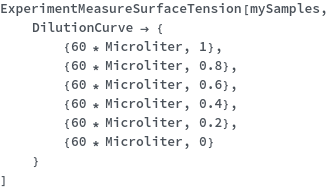

Sample Storage

Warnings and Errors
Messages (34)
CalibrantSurfaceTensionMismatch (1)
CannotSpecifyBothDilutionCurveAndSerialDilutionCurve (1)
ConflictingCleaningSolution (1)
ConflictingDilutionContainer (1)
ConflictingDilutionMixSettings (1)
ConflictingDilutionMixVolume (1)
ConflictingPreparedPlateCalibrants (1)
ConflictingPreparedPlateDilution (1)
ContainerOutMismatch (1)
DilutionContainerConflictingStorage (1)
DilutionContainerInsufficientVolume (1)
DilutionCurveExcessVolume (2)
IncompatableDilutionContainer (1)
InsufficientDilutionCurveVolume (1)
InvalidAssayPlate (1)
MeasureSurfaceTesnsionContainerOutConflictingStorage (1)
MissingCalibrantSurfaceTension (1)
MissingCleaningMethod (2)
MissingDilutionContainer (1)
MissingDilutionCurve (2)
MissingDilutionMixRate (1)
MissingDilutionMixVolume (1)
MissingDilutionNumberOfMixes (1)
MultipleAssayPlates (1)
MustSpecifyCleaningSolution (1)
NoCalibrantProvided (1)
PreparedPlateFalse (2)
Last modified on Tue 10 Jan 2023 14:57:12
